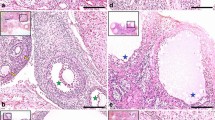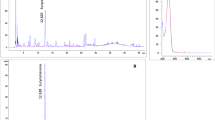Abstract
Introduction
Estrogen and prolactin affect vitamin D metabolism. In conditions such as pregnancy and lactation, their interaction in regulating vitamin D metabolism and circulating FGF23 is not clearly defined. The aim of this study is to investigate this interaction in female rats.
Method
This study was performed on 50 female adult rats, which were divided into five groups of Sham, ovariectomized rats (O), and three groups of ovariectomized rats were indicated with prolactin alone (OP), estradiol alone (OE), and a combination of estradiol and prolactin (OEP). Serum levels of 25(OH)D, 1,25(OH)2D3, FGF23, PTH, vitamin D-binding protein, calcium, and phosphorous were evaluated.
Results
Serum 1,25(OH)2D3 and PTH in OE were higher than the O group (P < 0.001 and P = 0.003, respectively). Serum FGF23 in the OE group was lower than the O group (P = 0.016). Serum 1,25(OH)2D3 increased in OP compared to the O group (P < 0.001) and OE group (P < 0.001). Serum FGF23 in OP was lower than the O group (P = 0.04). Furthermore, combining estradiol and prolactin showed no extra effect on increasing serum 1,25(OH)2D3. Serum 1,25(OH)2D3 was positively correlated with serum prolactin levels (r = 0.318, P = 0.017) in all five groups.
Conclusion
It is suggested that estradiol could increase 1,25(OH)2D3 by elevating PTH and decreasing serum FGF23; however, prolactin was able to increase 1,25(OH)2D3 by lowering serum FGF23. Moreover, prolactin was shown to be more potent in augmenting serum 1,25(OH)2D3 than estrogen itself, which is important in maternal and fetal calcium supply during late pregnancy and lactation.

Similar content being viewed by others
References
Rosen CJ (2011) Vitamin D insufficiency. N Engl J Med 364(3):248–254
Weisman Y et al (1979) 1α, 25-Dihydroxyvitamin D3, and 24, 25-dihydroxyvitamin D3 in vitro synthesis by human decidua and placenta. Nature 281(5729):317–319
Gray TK, Lester GE, Lorenc RS (1979) Evidence for extra-renal 1 alpha-hydroxylation of 25-hydroxyvitamin D3 in pregnancy. Science 204(4399):1311–1313
Stoffels K et al (2007) Immune regulation of 1α-hydroxylase in murine peritoneal macrophages: unravelling the IFNγ pathway. J Steroid Biochem Mol Biol 103(3):567–571
Wright NC et al (2012) Defining physiologically “normal” vitamin D in African Americans. Osteoporos Int 23(9):2283–2291
Pop LC et al (2015) Vitamin D-binding protein in healthy pre-and postmenopausal women: relationship with estradiol concentrations. Endocr Pract 21(8):936–942
Christakos S et al (2010) Vitamin D: metabolism. Endocr Metab Clin 39(2):243–253
Liu S et al (2006) Fibroblast growth factor 23 is a counter-regulatory phosphaturic hormone for vitamin D. J Am Soc Nephrol 17(5):1305–1315
Pike J et al (1978) Influence of estrogen on renal vitamin D hydroxylases and serum 1alpha, 25-(OH) 2D3 in chicks. Am J Physiol Endocrinol Metab 235(3):E338
Tanaka Y et al (1978) Synergistic Effect of Progesterone, Testosterone, and Estradiol in the Stimulation of Chick Renal 25-Hydroxyvitamin D3-lα-Hydroxylase. Endocrinology 103(6):2035–2039
Baksi SN, Kenny AD (1978) Does estradiol stimulate in vivo production of 1, 25-dihydroxyvitamin D3 in the rat? Life Sci 22(9):787–791
Robinson C et al (1982) Role of prolactin in vitamin D metabolism and calcium absorption during lactation in the rat. J Endocrinol 94(3):443–453
Fenton E, Britton H (1980) 25-Hydroxycholecalciferol 1α-hydroxylase activity in the kidney of the fetal, neonatal and adult guinea pig. Neonatology 37(5–6):254–256
Kubota M et al (1982) Vitamin D metabolism in pregnant rabbits: differences between the maternal and fetal response to administration of large amounts of vitamin D3. Endocrinology 110(6):1950–1956
Shimada T et al (2004) Targeted ablation of Fgf23 demonstrates an essential physiological role of FGF23 in phosphate and vitamin D metabolism. J Clin Invest 113(4):561
Kovacs CS, Kronenberg HM (1997) Maternal-fetal calcium and bone metabolism during pregnancy, puerperium, and lactation. Endocr Rev 18(6):832–872
Kovacs CS, Fuleihan GE-H (2006) Calcium and bone disorders during pregnancy and lactation. Endocrinol Metab Clin 35(1):21–51
Bansal N et al (2013) Influence of estrogen therapy on calcium, phosphorus, and other regulatory hormones in postmenopausal women: the MESA study. J Clin Endocrinol Metab 98(12):4890–4898
Millen AE et al (2010) Predictors of serum 25-hydroxyvitamin D concentrations among postmenopausal women: the Women's Health Initiative Calcium plus Vitamin D clinical trial. Am J Clinical Nutr 91(5):1324–1335
Harris SS, Dawson-Hughes B (1998) The association of oral contraceptive use with plasma 25-hydroxyvitamin D levels. J Am Coll Nutr 17(3):282–284
Thane CW, Bates CJ, Prentice A (2002) Oral contraceptives and nutritional status in adolescent British girls. Nutr Res 22(4):449–462
Møller UK et al (2013) Increased plasma concentrations of vitamin D metabolites and vitamin D binding protein in women using hormonal contraceptives: a cross-sectional study. Nutrients 5(9):3470–3480
Wolman R et al (2013) Vitamin D status in professional ballet dancers: winter vs summer. J Sci Med Sport 16(5):388–391
Hedlund L, Brembeck P, Olausson H (2013) Determinants of vitamin D status in fair-skinned women of childbearing age at northern latitudes. PLoS ONE 8(4):e60864
Tanaka Y, Castillo L, DeLuca H (1976) Control of renal vitamin D hydroxylases in birds by sex hormones. Proc Natl Acad Sci 73(8):2701–2705
Riggs BL, Khosla S, Melton LJ (1998) A unitary model for involutional osteoporosis: estrogen deficiency causes both type I and type II osteoporosis in postmenopausal women and contributes to bone loss in aging men. J Bone Miner Res 13(5):763–773
Nakamura T et al (2007) Estrogen prevents bone loss via estrogen receptor α and induction of Fas ligand in osteoclasts. Cell 130(5):811–823
Carrillo-López N, Román-García P, Rodríguez-Rebollar A, Fernández-Martín JL, Naves-Díaz M, Cannata-Andía JB (2009) Indirect regulation of PTH by estrogens may require FGF23. J Am Soc Nephrol 20(9):2009–2017. https://doi.org/10.1681/ASN.2008121258
Gallagher J, Riggs BL, Deluca HF (1980) Effect of estrogen on calcium absorption and serum vitamin D metabolites in postmenopausal osteoporosis. J Clin Endocrinol Metab 51(6):1359–1364
Liu S et al (2006) Pathogenic role of Fgf23 in Hyp mice. Am J Physiol Endocrinol Metab 291(1):E38–E49
Sitara D et al (2006) Genetic ablation of vitamin D activation pathway reverses biochemical and skeletal anomalies in Fgf-23-null animals. Am J Pathol 169(6):2161–2170
Ito N et al (2007) Fibroblast growth factor (FGF) 23 in patients with acromegaly. Endocr J 54(3):481–484
Shigematsu T et al (2004) Possible involvement of circulating fibroblast growth factor 23 in the development of secondary hyperparathyroidism associated with renal insufficiency. Am J Kidney Dis 44(2):250–256
Kazama JJ et al (2005) Pretreatment serum FGF-23 levels predict the efficacy of calcitriol therapy in dialysis patients. Kidney Int 67(3):1120–1125
Nakanishi S et al (2005) Serum fibroblast growth factor-23 levels predict the future refractory hyperparathyroidism in dialysis patients. Kidney Int 67(3):1171–1178
Ix JH et al (2011) Relation of sex and estrogen therapy to serum fibroblast growth factor 23, serum phosphorus, and urine phosphorus: the Heart and Soul Study. Am J Kidney Dis 58(5):737–745
Wetmore JB (2011) The link between estrogen and fibroblast growth factor 23. Am J Kidney Dis 58(5):695–696
Celik E et al (2013) The relationship between fibroblast growth factor 23 and osteoporosis in postmenopausal women. Minerva Med 104(5):497–504
Cundy T et al (1987) Remission of hypoparathyroidism during lactation: evidence for a physiological role for prolactin in the regulation of vitamin D metabolism. Clin Endocrinol 26(6):667–674
Caplan RH, Beguin EA (1990) Hypercalcemia in a calcitrioltreated hypoparathyroid woman during lactation. Obstet Gynecol 76(3, Part 2):485–489
Ajibade DV et al (2010) Evidence for a role of prolactin in calcium homeostasis: regulation of intestinal transient receptor potential vanilloid type 6, intestinal calcium absorption, and the 25-hydroxyvitamin D3 1α hydroxylase gene by prolactin. Endocrinology 151(7):2974–2984
Acknowledgements
The authors wish to thank the Research Consultation Center (RCC) at Shiraz University of Medical Sciences for their invaluable assistance in editing this manuscript.
Funding
There is no financial support.
Author information
Authors and Affiliations
Contributions
FS: design, data gathering, preparing the manuscript; SRK: data gathering, preparing the manuscript; FK: data gathering, preparing the manuscript; GRO: concept, design, data gathering, preparing the manuscript and the correspondence.
Corresponding author
Ethics declarations
Conflict of interest
Gholamhossein Ranjbar Omrani, Faezeh Sadeghian, Seyed Reza Kasaee, Farhad Koohpeima and Forough Saki declare that they have no conflict of interest.
Ethical approval
Shiraz University of Medical Sciences’ local ethics committee and vice-chancellor of research approved this study with ID: 95–01-01–12,776.
Human and animal rights
The study was done according to the ARRIVE (Animal Research: Reporting of in Vivo Experiments) guidelines on the use and care of research animals.
Informed consent
This study is an animal study, so Informed consent was not applicable.
Additional information
Publisher's Note
Springer Nature remains neutral with regard to jurisdictional claims in published maps and institutional affiliations.
Rights and permissions
About this article
Cite this article
Saki, F., Sadeghian, F., Kasaee, S.R. et al. Effect of prolactin and estrogen on the serum level of 1,25-dihydroxy vitamin D and FGF23 in female rats. Arch Gynecol Obstet 302, 265–271 (2020). https://doi.org/10.1007/s00404-020-05567-6
Received:
Accepted:
Published:
Issue Date:
DOI: https://doi.org/10.1007/s00404-020-05567-6




